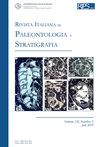来自欧洲群岛亚得里亚海岛的岛龙的不寻常的尾巴(恐龙,鸭嘴龙科)
IF 1.9
3区 地球科学
Q2 GEOLOGY
引用次数: 3
摘要
来自意大利东北部白垩纪晚期的基础鸭嘴龙(Tethyshadros insularis)生活在特提斯洋(Tethys Ocean)欧洲群岛的一个岛屿上。这只恐龙的尾巴与其他同时期的群岛鸭嘴龙和一般鸭嘴龙的尾巴相比,呈现出几个非对称特征。全模标本尾巴的估计长度显示,尾巴较长,至少占体长的56%,近端相对坚硬且较深,而远端则呈鞭状。通过与现存的始祖龙和其他恐龙进行比较,重建了尾肌组织,这表明第一血骺的后移影响了尾骨龙的大小和形状,并对岛龙的运动产生了重要影响。这种恐龙的姿态和步态有些奇特,也可以从四肢特征中看出。通风口的后移和由此产生的较长的肠远端束或较长的泄殖腔可增加尿的储存空间和尿水的再吸收。出口的后移也可能意味着更长的输卵管和每窝卵的数量增加。岛龙的尾巴形态可能与意大利恐龙生活的崎岖和缺水的喀斯特地貌有关。两个主要的岛蝗标本在健壮性上的差异可能是由于两性二态性、个体发育或高度的种内变异性。本文章由计算机程序翻译,如有差异,请以英文原文为准。
The unusual tail of Tethyshadros Insularis (Dinosauria, Hadrosauroidea) from the Adriatic Island of the European Archipelago
The basal hadrosauroid Tethyshadros insularis from the uppermost Cretaceous of NE Italy lived on an island of the European archipelago in the Tethys Ocean. The tail of this dinosaur presents several apomorphic traits respect to the tails of other coeval hadrosauroids of the archipelago and of hadrosauroids in general. The estimated total length of the tail of the holotypic specimen shows that the tail was long, accounting for at least 56% of the total body length, relatively stiff and deep proximally, whereas it was whip-like distally. The reconstruction of the tail musculature by comparison with that of living archosaurs and other dinosaurs suggests that the posterior shift of the first haemapophysis affected the size and shape of the M.m. caudofemorales with important consequences on the locomotion of T. insularis. Somewhat peculiar stance and gait for this dinosaur are suggested also by limb features. The posterior shift of the vent and consequent longer distal tract of the intestine or a longer cloaca could increase the space for urine storage and urinary water reabsorption. The posterior shift of the vent could imply also longer oviducts and plausibly an increased number of eggs per clutch. Tail apomorphies of T. insularis may be related to the rugged and water-depleted karst landscape where the Italian dinosaur lived. The two main specimens of T. insularis differ in robustness possibly because of sexual dimorphism, ontogeny or high intraspecific variability.
求助全文
通过发布文献求助,成功后即可免费获取论文全文。
去求助
来源期刊
CiteScore
3.60
自引率
4.30%
发文量
28
审稿时长
>12 weeks
期刊介绍:
The Rivista Italiana di Paleontologia e Stratigrafia was founded in 1895. It publishes original papers dealing with all fields of paleontology and of stratigraphy, from Italy and the Mediterranean to the Tethys, as well across the globe from China to North America.

 求助内容:
求助内容: 应助结果提醒方式:
应助结果提醒方式:


